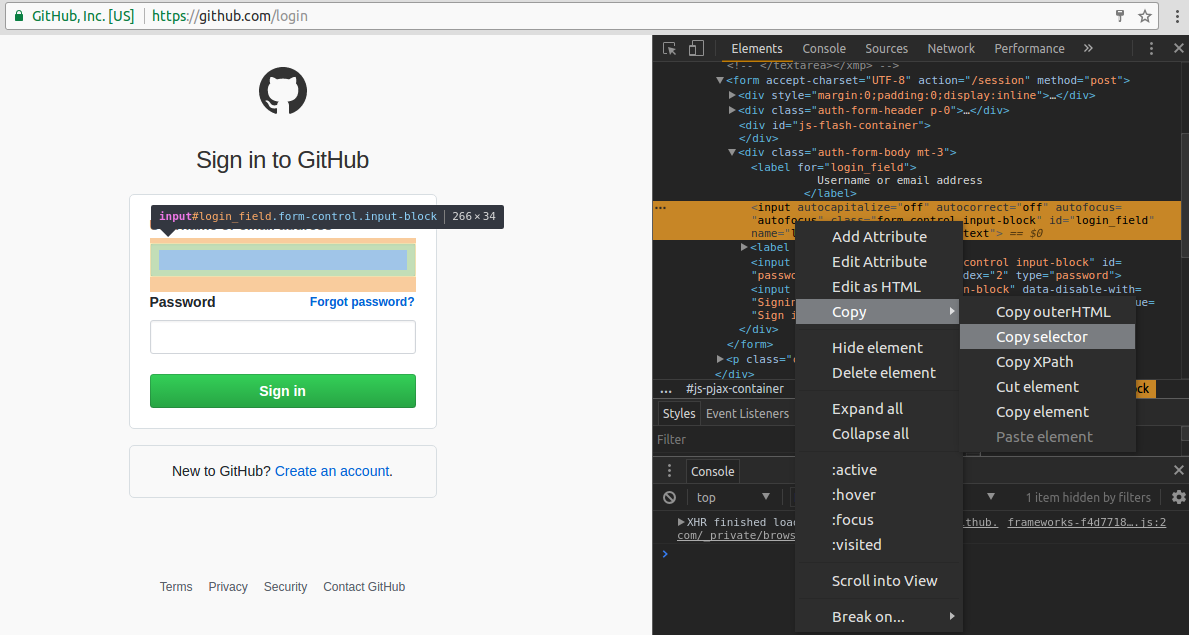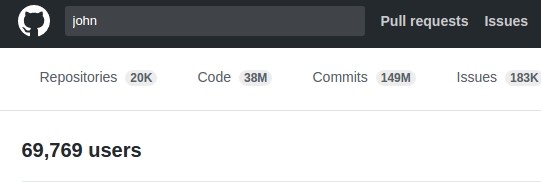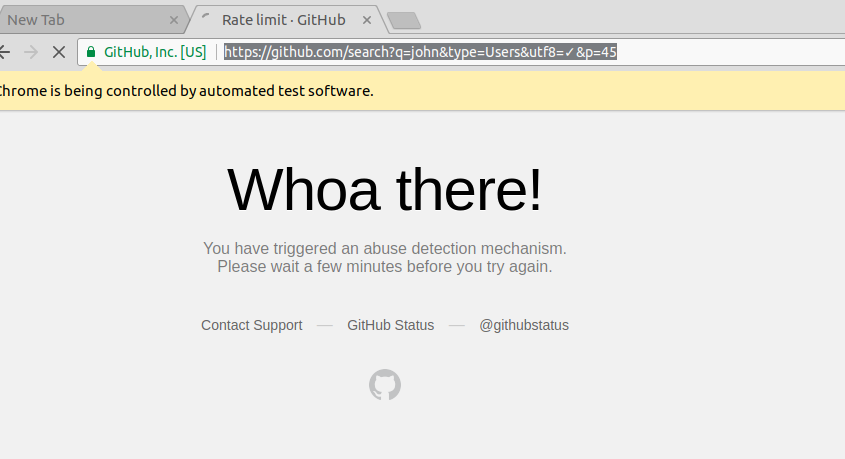Here is a link to Medium Article
Here is the Chinese Version thanks to @csbun
Puppeteer is official tool for Chrome Headless by Google Chrome team. Since the official announcement of Chrome Headless, many of the industry standard libraries for automated testing have been discontinued by their maintainers. Including PhantomJS. Selenium IDE for Firefox has been discontinued due to lack of maintainers.
For sure, Chrome being the market leader in web browsing, Chrome Headless is going to industry leader in Automated Testing of web applications. So, I have put together this starter guide on how to get started with Web Scraping in Chrome Headless.
In this guide we will scrape GitHub, login to it and extract and save emails of users using Chrome Headless, Puppeteer, Node and MongoDB. Don't worry GitHub have rate limiting mechanism in place to keep you under control but this post will give you good idea on Scrapping with Chrome Headless and Node. Also, alway stay updated with the documentation because Puppeteer is under development and APIs are prone to changes.
Before we start, we need following tools installed. Head over to their websites and install them.
Start off by making the project directory
$ mkdir thal
$ cd thal
Initiate NPM. And put in the necessary details.
$ npm init
Install Puppeteer. Its not stable and repository is updated daily. If you want to avail the latest functionality you can install it directly from its GitHub repository.
$ npm i --save puppeteer
Puppeteer includes its own chrome / chromium, that is guaranteed to work headless. So each time you install / update puppeteer, it will download its specific chrome version.
We will start by taking a screenshot of the page. This is code from their documentation.
const puppeteer = require('puppeteer');
async function run() {
const browser = await puppeteer.launch();
const page = await browser.newPage();
await page.goto('https://github.com');
await page.screenshot({ path: 'screenshots/github.png' });
browser.close();
}
run();If its your first time using Node 7 or 8, you might be unfamiliar with async and await keywords. To put async/await in really simple words, an async function returns a Promise. The promise when resolves might return the result that you asked for. But to do this in a single line, you tie the call to async function with await.
Save this in index.js inside project directory.
Also create the screenshots dir.
$ mkdir screenshots
Run the code with
$ node index.js
The screenshot is now saved inside screenshots/ dir.
If you go to GitHub and search for john, then click the users tab. You will see list of all users with names.
Some of them have made their emails publicly visible and some have chosen not to. But the thing is you can't see these emails without logging in. So, lets login. We will make heavy use of Puppeteer documentation.
Add a file creds.js in project root. I highly recommend signing up for new account with a new dummy email because you might end up getting your account blocked.
module.exports = {
username: '<GITHUB_USERNAME>',
password: '<GITHUB_PASSWORD>'
}Add another file .gitignore and put following content inside it:
node_modules/
creds.jsFor visual debugging, make chrome launch with GUI by passing an object with headless: false to launch method.
const browser = await puppeteer.launch({
headless: false
});Lets navigate to login
await page.goto('https://github.com/login');Open https://github.com/login in your browser. Right click on input box below Username or email address and select Inspect. From developers tool, right click on the highlighted code and
select Copy then Copy selector.
Paste that value to following constant
const USERNAME_SELECTOR = '#login_field'; // "#login_field" is the copied valueRepeat the process for Password input box and Sign in button. You would have following
// dom element selectors
const USERNAME_SELECTOR = '#login_field';
const PASSWORD_SELECTOR = '#password';
const BUTTON_SELECTOR = '#login > form > div.auth-form-body.mt-3 > input.btn.btn-primary.btn-block';Puppeteer provides methods click to click a DOM element and type to type text in some input box. Let's fill in the credentials then click login and wait for redirect.
Up on top, require creds.js file.
const CREDS = require('./creds');And then
await page.click(USERNAME_SELECTOR);
await page.keyboard.type(CREDS.username);
await page.click(PASSWORD_SELECTOR);
await page.keyboard.type(CREDS.password);
await Promise.all([
page.click(BUTTON_SELECTOR),
page.waitForNavigation()
])Now, we have logged in. We can programmatically click on search box, fill it and on the results page, click users tab. But there's an easy way. Search requests are usually GET requests. So, every thing is sent via url. So, manually type john inside search box and then click users tab and copy the url. It would be
const searchUrl = 'https://github.com/search?q=john&type=Users&utf8=%E2%9C%93';Rearranging a bit
const userToSearch = 'john';
const searchUrl = `https://github.com/search?q=${userToSearch}&type=Users&utf8=%E2%9C%93`;Lets navigate to this page and wait to see if it actually searched?
await page.goto(searchUrl);
await page.waitFor(2*1000);We are interested in extracting username and email of users. Lets copy the DOM element selectors like we did above.
const LIST_USERNAME_SELECTOR = '#user_search_results > div.user-list > div:nth-child(1) div.d-flex > div > a';
const LIST_EMAIL_SELECTOR = '#user_search_results > div.user-list > div:nth-child(1) div.d-flex > div > ul > li:nth-child(2) > a';
const LENGTH_SELECTOR_CLASS = 'user-list-item';You can see that I also added LENGTH_SELECTOR_CLASS above. If you look at the github page's code inside developers tool, you will observe that divs with class user-list-item are actually housing information about a single user each.
Currently one way to extract text from an element is by using evaluate method of Page or ElementHandle. When we navigate to page with search results, we will use page.evaluate method to get the length of users list on the page. The evaluate method evaluates the code inside browser context.
let listLength = await page.evaluate((sel) => {
return document.getElementsByClassName(sel).length;
}, LENGTH_SELECTOR_CLASS);Let's loop through all the listed users and extract emails. As we loop through the DOM, we have to change index inside the selectors to point to the next DOM element. So, I put the INDEX string at the place where we want to place the index as we loop through.
// const LIST_USERNAME_SELECTOR = '#user_search_results > div.user-list > div:nth-child(1) div.d-flex > div > a';
const LIST_USERNAME_SELECTOR = '#user_search_results > div.user-list > div:nth-child(INDEX) div.d-flex > div > a';
// const LIST_EMAIL_SELECTOR = '#user_search_results > div.user-list > div:nth-child(1) div.d-flex > div > ul > li:nth-child(2) > a';
const LIST_EMAIL_SELECTOR = '#user_search_results > div.user-list > div:nth-child(INDEX) div.d-flex > div > ul > li:nth-child(2) > a';
const LENGTH_SELECTOR_CLASS = 'user-list-item';The loop and extraction
for (let i = 1; i <= listLength; i++) {
// change the index to the next child
let usernameSelector = LIST_USERNAME_SELECTOR.replace("INDEX", i);
let emailSelector = LIST_EMAIL_SELECTOR.replace("INDEX", i);
let username = await page.evaluate((sel) => {
return document.querySelector(sel).getAttribute('href').replace('/', '');
}, usernameSelector);
let email = await page.evaluate((sel) => {
let element = document.querySelector(sel);
return element? element.innerHTML: null;
}, emailSelector);
// not all users have emails visible
if (!email)
continue;
console.log(username, ' -> ', email);
// TODO save this user
}Now if you run the script with node index.js you would see usernames and there corresponding emails printed.
First we would estimate the last page number with search results. At search results page, on top, you can see 69,769 users at the time of this writing.
Fun Fact: If you compare with the previous screenshot of the page, you will notice that 6 more john s have joined GitHub in the matter of a few hours.
Copy its selector from developer tools. We would write a new function below the run function to return the number of pages we can go through.
async function getNumPages(page) {
const NUM_USER_SELECTOR = '#js-pjax-container > div.container > div > div.column.three-fourths.codesearch-results.pr-6 > div.d-flex.flex-justify-between.border-bottom.pb-3 > h3';
let inner = await page.evaluate((sel) => {
let html = document.querySelector(sel).innerHTML;
// format is: "69,803 users"
return html.replace(',', '').replace('users', '').trim();
}, NUM_USER_SELECTOR);
let numUsers = parseInt(inner);
console.log('numUsers: ', numUsers);
/*
* GitHub shows 10 resuls per page, so
*/
let numPages = Math.ceil(numUsers / 10);
return numPages;
}At the bottom of the search results page, if you hover the mouse over buttons with page numbers, you can see they link to the next pages. The link to 2nd page with
results is https://github.com/search?p=2&q=john&type=Users&utf8=%E2%9C%93. Notice the p=2 query parameter in the URL. This will help us navigate to the next page.
After adding an outer loop to go through all the pages around our previous loop, the code looks like
let numPages = await getNumPages(page);
console.log('Numpages: ', numPages);
for (let h = 1; h <= numPages; h++) {
let pageUrl = searchUrl + '&p=' + h;
await page.goto(pageUrl);
let listLength = await page.evaluate((sel) => {
return document.getElementsByClassName(sel).length;
}, LENGTH_SELECTOR_CLASS);
for (let i = 1; i <= listLength; i++) {
// change the index to the next child
let usernameSelector = LIST_USERNAME_SELECTOR.replace("INDEX", i);
let emailSelector = LIST_EMAIL_SELECTOR.replace("INDEX", i);
let username = await page.evaluate((sel) => {
return document.querySelector(sel).getAttribute('href').replace('/', '');
}, usernameSelector);
let email = await page.evaluate((sel) => {
let element = document.querySelector(sel);
return element? element.innerHTML: null;
}, emailSelector);
// not all users have emails visible
if (!email)
continue;
console.log(username, ' -> ', email);
// TODO save this users
}
}The part with puppeteer is over now. We will use mongoose to store the information in to MongoDB. Its an ORM, actually just a library to facilitate information storage and retrieval from the database.
$ npm i --save mongoose
MongoDB is a Schema-less NoSQL database. But we can make it follow some rules using Mongoose. First we would have to create a Model which is just representation of MongoDB Collection in code. Create a directory models. Create a file user.js inside and put the following code in it, the structure of our collection. Next whenever we insert something into users collection with mongoose, it would have to follow this structure.
const mongoose = require('mongoose');
let userSchema = new mongoose.Schema({
username: String,
email: String,
dateCrawled: Date
});
let User = mongoose.model('User', userSchema);
module.exports = User;Let's now actually insert. We don't want duplicate emails in our database. So, we only insert a user's information if the email is not already present. Otherwise we would just update the information. For this we would use mongoose's Model.findOneAndUpdate method.
At the top of index.js add the imports
const mongoose = require('mongoose');
const User = require('./models/user');Add the following function at bottom of index.js to upsert (update or insert) the User model
function upsertUser(userObj) {
const DB_URL = 'mongodb://localhost/thal';
if (mongoose.connection.readyState == 0) {
mongoose.connect(DB_URL);
}
// if this email exists, update the entry, don't insert
const conditions = { email: userObj.email };
const options = { upsert: true, new: true, setDefaultsOnInsert: true };
User.findOneAndUpdate(conditions, userObj, options, (err, result) => {
if (err) throw err;
});
}Start MongoDB server. Put following code inside the for loops at the place of comment // TODO save this user in order to save the user
upsertUser({
username: username,
email: email,
dateCrawled: new Date()
});To check if you are actually getting users saved, get inside mongo shell
$ mongo
> use thal
> db.users.find().pretty()
You would see multiple users added there. This marks the crux of this guide.
Chrome Headless and Puppeteer is the start of a new era in Web Scraping and Automated Testing. Chrome Headless also supports WebGL. You can deploy your scraper in cloud and sit back and let it do the heavy load. Remember to remove the headless: false option when you deploy on server.
- While scraping, you might be halted by GitHub's rate limiting
- Another thing I noticed, you cannot go beyond 100 pages on GitHub.
Deserts symbolize vastness and are witness of the struggles and sacrifices of people who traversed through these giant mountains of sand. Thal is a desert in Pakistan spanning across multiple districts including my home district Bhakkar. Somewhat similar is the case with Internet that we traversed today in quest of data. That's why I named the repository Thal. If you like this effort, please like and share this with others. If you have any suggestions, comment here or approach me directly @e_mad_ehsan. I would love to hear from you.





